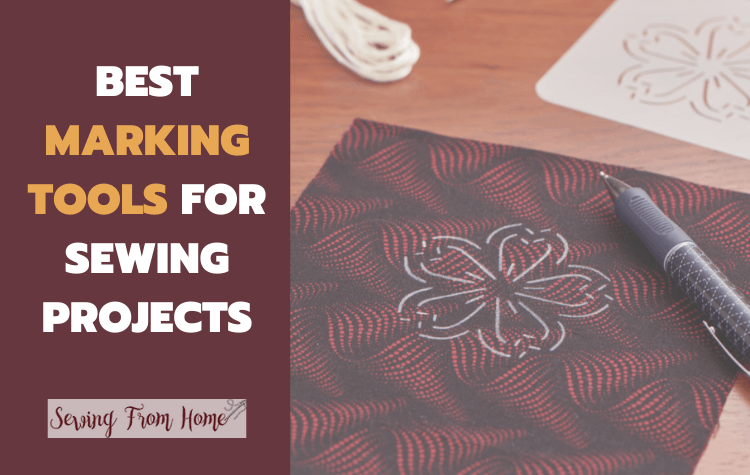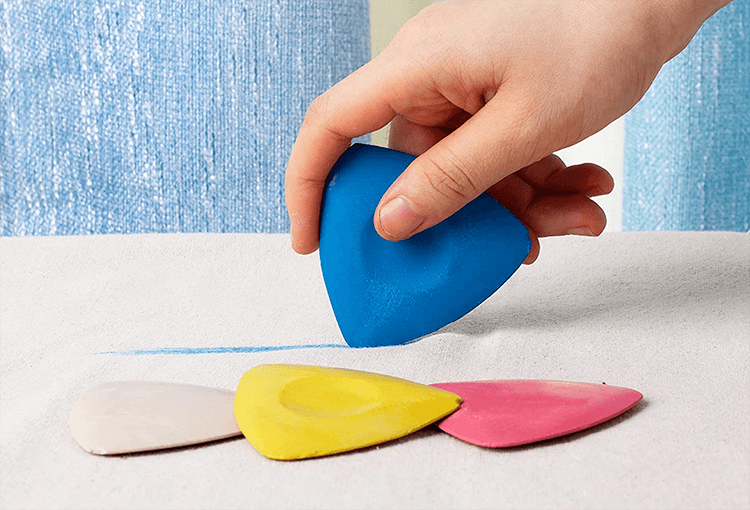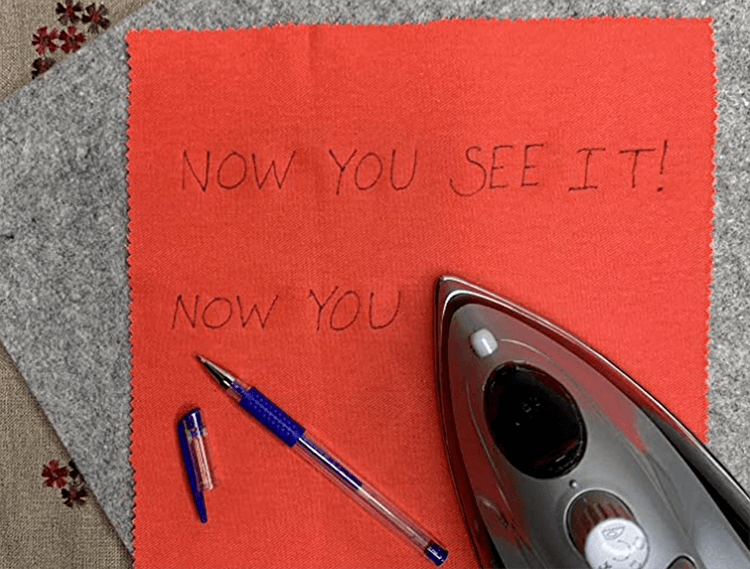Every sewing project is made far easier with a set of good marking tools. Regardless of what you are making or what materials you are using, marking your stitch lines before you sew is crucial.
There are several marking tools available on the market right now that can do this job very well, but some are significantly better than others.
The best marking tools for sewing include disappearing ink markers, chalk pencils, chalk cartridge pens, tailor’s chalk, chalk dust liner pens, chalk wheels, washable markers, a tracing wheel and carbon paper, soft lead pencils, soap, ceramic lead pens, and even ballpoint pens.
Knowing which marking tools are best for you and for the materials that you are using is important, as not every marking tool will work on all materials, and some may end up damaging certain materials.
Let’s explore the best marking tools for sewing on the market right now to give you an understanding of how they work and how well they function.
- What Are The Best Marking Tools For Sewing?
- 1. Disappearing Ink Markers
- 2. Chalk Pencils
- 3. Chalk Cartridge Pens
- 4. Tailor’s Chalk
- 5. Chalk Dust Liner Pens
- 6. Chalk Wheel
- 7. Washable Markers
- 8. Tracing Wheel And Carbon Paper
- 9. Soft Lead Pencil
- 10. Soap
- 11. Ballpoint Pens
- 12. Ceramic Lead Pens
- Choosing A Sewing Marking Tool
What Are The Best Marking Tools For Sewing?

1. Disappearing Ink Markers
Disappearing ink markers have become a standard in the industry, as the good-quality versions of this marking tool are reliable, accurate, and easy to use.
These markers feature a specialized ink that disappears when exposed to heat, bright light, friction, or simply by exposure to air for a few minutes. The way the ink disappears depends on the brand, and it is important to find a marker that leaves lines that last for as long as you need them to without disappearing.
Disappearing ink markers can be found in multiple colors for use on multiple fabric colors; they can be used on all fabrics, they do not pull fabrics, and they are easily available, inexpensive, and they are very effective.
However, only the high-quality disappearing ink markers are safe for use on all fabrics, as the low-quality versions may leave permanent marks or they may cause damage to some delicate fabrics.
2. Chalk Pencils
Chalk has been a preferred marking medium for sewing for centuries, but the regular chalk sticks can be very difficult to use, and they can be inaccurate.
Chalk pencils are the answer to this issue. These marking tools are similar to regular pencils, but they contain chalk rather than graphite. This means that they can be sharpened the same as regular pencils, they are as reliable as regular pencils, and they are as straightforward to use as regular pencils.
These specialized pencils are easy to keep sharp, they will work on all fabrics except those that are very thick and textured, such as wools, and they will not cause any damage to any material.
These pencils are also inexpensive to buy, and they are easily available as well, which makes them the ideal marking tool in most situations,
3. Chalk Cartridge Pens
Chalk cartridge pens follow the same concept as mechanical pencils. These pens use chalk refills that are clicked through the nib with a mechanism, making them very straightforward to use.
These cartridge pens are somewhat expensive, and the chalk that they use is very fragile, which can make them challenging to use effectively.
Using this type of chalk pen is simple, but it can be frustrating when the chalk breaks. However, they do work on almost all fabric types, and they will never cause damage. They are also very accurate as the chalk remains the same size as it is used.
4. Tailor’s Chalk
Tailor’s chalk has been used by those in the textile industry for as long as most of us can remember. Whether you are a professional, part-time pro, or a hobbyist, tailor’s chalk is an ideal marking tool.
This is a rectangular piece of chalk that is very simple to use. It has three sharp edges and three points, which makes it a very versatile marking tool for all uses.
The only drawback to this marking tool is that they are not very durable, and they become dull very quickly. This can be overcome by sharpening the chalk with a chalk sharpener or by simply sharpening it on a slightly rough surface.
Tailor’s chalk can be used on almost any material or fabric, but using them on rough fabrics will cause it to wear down more quickly.

5. Chalk Dust Liner Pens
The main brand of chalk dust liner pens is Chaco Liners. This type of material marker has a cartridge of chalk dust released through a thin nub.
This marker has several advantages, including the fact that it never needs to be sharpened, it lasts for a very long time provided you have a supply of refills, and it is very easy to use.
However, these markers are expensive, and they can be difficult to find. If you can get hold of one, it may become your favorite marker for sewing, as it is very reliable and very easy to use; the chalk powder easily rubs off but will not disappear before you want it to.
6. Chalk Wheel
The chalk wheel is a product designed specifically for marking fabrics and can be thought of as a combination of a chalk liner and a tracing wheel.
This clever device is compact and contains a replaceable cartridge filled with chalk dust. The tip of each cartridge has a small wheel with teeth similar to a tracing wheel. As you drag the wheel across a piece of fabric, it leaves behind a crisp, accurate line of chalk that can be easily removed and will not damage any fabrics.
The cartridges for the chalk wheel are available in multiple colors for use on fabrics of different colors, and the product will work exceptionally well on all fabrics that are not too coarse or porous.
7. Washable Markers

Washable markers are another excellent tool for making fabrics and materials. These makers can be found in many various forms, shapes, types, and price points, but the most readily available source of washable markers is those that are meant for children.
These markers are meant to leave lines that are easily washed out of clothes, but they are simple to use, clearly visible, can be used on every type of material, are available in multiple colors, and are very inexpensive to buy.
Simply wash the clothing that you make after completing it, and every marker line you make in the process will be simply washed away. These are excellent markers for those who require extra visible lines that do not fade on their own.
8. Tracing Wheel And Carbon Paper
Using carbon paper and a tracing wheel is a classic method for marking fabrics. This process is very simple to do, and it is very effective, but it can be somewhat cumbersome and does require some practice to get right.
A tracing wheel has a series of points that poke through carbon paper as it is pushed along the material, leaving carbon from the carbon paper behind, making lines on the fabric.
The major advantage of using a tracing wheel and carbon paper is that you can draw your design lines, creases, and stitch locations on the carbon paper with whatever marker you want and use the tracing wheel to transfer them onto your fabric.
Be careful not to get the carbon paper wet, and be aware of smudging, especially on light-colored materials. This method should work well for almost all types of sewing applications.
9. Soft Lead Pencil
This is a marking tool that is often neglected and forgotten, but a soft lead pencil is something that most households already have lying around, and it can be an excellent temporary marking tool for certain fabrics.
These pencils do not work on everything, but they work well enough on most things, and they will not cause any damage. Using some water to wipe the pencil marks off the clothing or washing the material easily removes the lines that these pencils make.
Soft lead pencils are easy to keep sharp, which makes them very accurate for marking, and they are wonderfully simple to use. Beware that they do not work on everything, but they should leave a visible line on most material types.
10. Soap
Using soap is another classic marking method, but it is often forgotten by modern sewing techniques, but it is surprisingly effective in some instances.
Simply slice a pointed wedge of soap and drag it along your material. This should leave a line on most rigid fabrics, especially those such as denim and those with dark colors.
Removing the lines that soap leaves can be tricky, but applying some heat with an iron or a hot wash should simply remove the lines.
11. Ballpoint Pens
If you do not have another option, and you need to make your fabrics somewhere where the lines will not be seen, a ballpoint pen is a good option. A ballpoint pen with liquid ink is especially effective and will leave lines on any type of material.
Ballpoint ink can stain most materials, so be sure to only use this type of marker where it cannot be seen, especially when the project is completed. No amount of washing can remove these stains, but if the lines are left hidden, a ballpoint pen is an ideal marking tool.
12. Ceramic Lead Pens
The last marker on the list is not the least and happens to be a favorite among many. These pens have a ceramic lead that is interchangeable, and there are multiple colors available as well.
These produce clear, crisp lines on any material that is not too textured, and the ceramic lines left behind are easily removable by friction or water.
Ceramic lead pens are, however, very expensive for a marking tool, and they are very difficult to find reliable, which is the only reason why they are so far down on the list.
Choosing A Sewing Marking Tool
There are several good marking tools that can be used for sewing, but everyone has their own preferences and preferred tools.
Everyone who sews needs a set of marking tools to mark different fabrics, so be sure to find a few that work well for you.
Take the time to find the right fabric marking tools for you, and it will make your workflow far smoother and the process of sewing designs far easier. The right marking tools for you are out there; it will simply take some exploration to find them!
See next: our guide to sourcing cheap fabrics for your marking tools.
